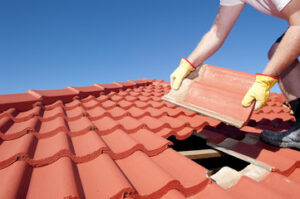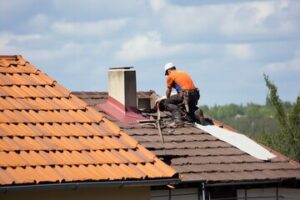Roof company provides high-level customer service for their customers. This includes everything from helping homeowners with insurance claims to providing home inspections for real estate agents.

These companies have significant profit margins, and many of them advertise their services through a variety of channels. This may include business cards, social media, branded websites and newsletters.
A professional roofing company will take the time to meet with homeowners and explain their options. They will answer any questions and concerns and provide a written estimate that includes all work to be done, materials used and the expected timeline. They can also assist with insurance claims and other paperwork.
A well-established roofer will have a strong online presence and a website that is optimized for search engines, such as Google. The company’s website will include a description of the types of roofing services provided and pictures of past jobs. It will also have a contact form for people to request an appointment. In addition to a website, the company will have social media accounts on popular platforms such as TikTok, Instagram and Pinterest. They will also set up a listing on Angi, a site that connects homeowners with local service providers.
New roofing business owners often worry about legal processes and bookkeeping, which can feel like intimidating tasks. But with modern software and plenty of resources available online, these tasks can be much easier than they appear. For example, freelance bookkeepers are often affordable and can be hired for a few hours a week to handle the basic accounting needs of a small roofing business.
When choosing a name for a roofing business, a new owner should think about what type of customers they want to attract and choose a name that is memorable. They should avoid names that are long or difficult to pronounce, use unfamiliar words or contain business tags such as LLC or Inc., which may require them to file fictitious name registration paperwork with their local government.
A reputable roofing company will carry general liability insurance and workers’ compensation. They will also have a vehicle and equipment insurance to cover any damage or loss to their vehicles and tools. Additionally, they will have a reputation management specialist to monitor their online reviews and respond to any negative comments quickly and effectively. This is an important step in building trust, which can make or break a roofing business.
High-Quality Materials
Whether you are building a new construction project or renovating an existing one, choosing high-quality materials will help you get the most out of your investment. These materials are not only stronger and more durable than their cheap counterparts, but they will also look better and last longer.
High-quality materials are designed to withstand different environmental conditions, and they offer superior resistance against various damages. This durability can greatly reduce your maintenance costs, as you will need to repair or replace less often. Additionally, many top-tier materials are eco-friendly and help reduce your carbon footprint.
In addition to offering superior durability, high-quality materials are also safer than low-grade ones. Some low-quality materials have been known to release harmful chemicals during the manufacturing process, which can pose a health risk for workers. On the other hand, high-quality materials are generally safe for human use and will not cause harm to employees or the environment.
When it comes to commercial and residential roofing, the quality of your materials can significantly affect your roof’s longevity. The higher-quality roofing materials will be able to resist wear and tear more easily than their cheaper counterparts, which can save you money in the long run on repairs or replacements.
Another benefit of choosing high-quality roofing materials is that they can actually increase the value of your property. This is because they are more attractive and can boost your home’s curb appeal, which can make it more appealing to potential buyers in the future.
Finally, using high-quality materials can help you build a reputation as a professional in the construction industry. When prospective clients see that you’re using premium materials, they will know that you are dedicated to providing a long-lasting and strong structure. This will encourage them to work with you in the future, as they will trust that their project is in good hands.
Local Expertise
Local roofing contractors have an in-depth understanding of the climate in the area and how it affects roof materials. This knowledge allows them to recommend roof replacement or repair solutions that will stand up well against local weather conditions and other environmental factors. Local roofing contractors also know the municipal rules and regulations that govern home improvement projects. This knowledge can help them avoid costly mistakes that might otherwise trip up national or out-of-state roofing companies.
Quality local roofing contractors are proud to serve their community. They’re devoted to their clients and they take the time to make sure every aspect of a job is done correctly. They aren’t satisfied until they’ve made a client happy. National or out-of-town roofing contractors are less likely to go the extra mile for their clients.
When choosing a roofing company, it’s important to read reviews online. Look for high star ratings and testimonials from past customers. You can also find out if your roofer is accredited by manufacturers like GAF or Owens Corning. These accreditations can boost your reputation in the industry and ensure you’re a qualified contractor.
Another way to find a reputable local roofer is to ask for referrals from friends and family members. A good referral can make all the difference in a project.
If you’re not getting many referrals, try advertising your roofing services in the local paper or on the radio. You can also use pamphlets or fliers to spread the word about your business. A door-to-door sales pitch can be very effective, too.
A shady roofing contractor may scam homeowners by adding products or add-ons to their estimates that aren’t necessary or by charging the insurance company for things they didn’t do. This is why it’s so important to choose a reputable roofing company that has a good track record in the community. It’s also wise to get a few different estimates before committing to a project. A professional should be able to produce a well-written, detailed estimate on site. If they need to email or call you later, it’s probably a bad sign.
Customer Service
Customers are placed in a position of trust when choosing a roofing contractor, so it’s important to demonstrate excellent customer service at every touch point. From communicating project timelines and providing updates to being on-site and helping clients file insurance claims, roofing contractors that prioritize their customers’ needs will stand out from the competition.
Ensure the best-in-class customer experience with premier integrations to CRM, service, ticketing, communications, collaboration, accounting and ERP apps that help you streamline operations and provide better customer service. Get a 360-degree view of your business with in-depth and customized reports.
Streamline the process of creating and converting estimates into invoices, managing inventory, and ensuring timely invoice payment with a single software solution. Zuper integrates with the leading CRM, service, ticketing, communications, and field management applications so you can deliver a seamless customer journey from quote to cash.

